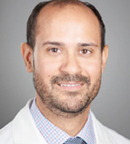
Michael Jain, MD, PhD
Michael Jain, MD, PhD, of the Moffitt Cancer Center, Tampa, Florida, commented on both studies with the combination of brentuximab vedotin/nivolumab.
“For older patients, ABVD [doxorubicin, bleomycin, vinblastine, dacarbazine] is not easy to tolerate, and it would be good to find an easier regimen. In this small study of older patients, these results were impressive. These older patients had quite a high durable response rate. We need longer follow-up to determine the relapse rate,” Dr. Jain noted.
However, Dr. Jain noted that larger studies are needed to confirm these findings. “We need to view these results with caution, because this is a 21-person study,” Dr. Jain continued. “However, there are not a lot of good options. Brentuximab vedotin/nivolumab is an interesting regimen and adds another option for elderly patients. For now, for a fit 75-year-old, you could try to reduce the dose of cytotoxic chemotherapy; and for quite a sick patient, you could use brentuximab vedotin alone, try brentuximab vedotin/nivolumab, or lower the dose of chemotherapy to get the disease under control.”
‘Remarkable’ Data in Salvage Setting
Turning to the second study of brentuximab vedotin/nivolumab as salvage therapy, Dr. Jain explained: “The majority of patients with Hodgkin lymphoma—between 70% and 95%—are cured by ABVD. However, certain subgroups do not have as good outcomes. Both brentuximab vedotin and nivolumab are approved in Hodgkin lymphoma as monotherapy in front-line treatment or to replace bleomycin in ABVD, and nivolumab is approved as a second-line or later option. The combination can replace cytotoxic chemotherapy as salvage therapy and may be a bridge to transplant.”
Dr. Jain continued: “ASCT in Hodgkin lymphoma works best in patients with a complete response, and you need a high complete response rate for a salvage regimen. The goal is to develop an effective salvage regimen that is less toxic and facilitates ASCT. These data on brentuximab vedotin/nivolumab are remarkable—a complete response rate of 67% and an overall response rate of 85%. Almost all patients were able to go on to ASCT.”
“With longer-term follow-up, the vast majority are in remission. Brentuximab vedotin/nivolumab looks like a good second-line regimen to facilitate ASCT,” added Dr. Jain. When asked whether community oncologists would adopt this approach without a phase III trial, Dr. Jain replied: “Community oncologists are comfortable with both of these drugs, and I think they will consider this as an option for second-line treatment.”
“Patients being considered for ASCT will go to larger centers that treat high volumes of patients with lymphoma,” Dr. Jain noted, “and oncologists will recommend this regimen to community oncologists, a ‘trickle-down’ effect.” ■
DISCLOSURE: Dr. Jain has been a consultant or advisor for Kite/Gilead.

